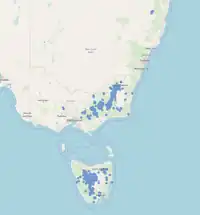| Alpine baeckea | |
|---|---|
 | |
| Baeckea gunniana | |
| Scientific classification | |
| Kingdom: | Plantae |
| Clade: | Tracheophytes |
| Clade: | Angiosperms |
| Clade: | Eudicots |
| Clade: | Rosids |
| Order: | Myrtales |
| Family: | Myrtaceae |
| Genus: | Baeckea |
| Species: | B. gunniana |
| Binomial name | |
| Baeckea gunniana | |
 | |
| Distribution map from the Atlas of Living Australia[2] | |
| Synonyms[1] | |
| |
Baeckea gunniana, commonly known as alpine baeckea,[3] is a species of flowering plant in the family Myrtaceae and is endemic to alpine and sub-alpine areas of south-eastern Australia. It is a densely-branched shrub with egg-shaped to oblong leaves and small white flowers with four to six stamens.
Description
Baeckea gunniana is a smooth, compact shrub growing up to 1.5 m (4 ft 11 in) high, although it can reach up to 2 m (6 ft 7 in) at lower altitudes. It is sometimes prostrate, spreading over rocks and boulders. The branchlets have papery or fibrous brown bark. The leaves are crowded, elliptical to egg-shaped with the narrower end towards the base, 1.9–3.8 mm (0.075–0.150 in) long, 0.9–1.4 mm (0.035–0.055 in) wide on a petiole about 0.5 mm (0.020 in) long and have smooth edges. The flowers up to 5 mm (0.20 in) in diameter and are borne singly in upper leaf axils, each flower on a pedicel 0.4–1 mm (0.016–0.039 in) long. The sepals are triangular to oblong, 0.6–0.8 mm (0.024–0.031 in) long and the petals are white, more or less round and 1.5–1.8 mm (0.059–0.071 in) long. There are four to six stamens all about the same length. The ovary has a single locule, the style is needle-shaped and in a small dent in the top of the ovary. (The unilocular ovary is unique in the genus.) The fruit is a cup-like capsule, the seeds small and angular, remaining inconspicuous on the ground upon release.[3][4][5][6][7]
Taxonomy and phylogeny
Baeckea gunniana was first formally described in 1843 by the German botanist Johannes Conrad Schauer in Walpers' book Repertorium Botanices Systematicae.[8][9] The specific epithet (gunniana) honours Ronald Campbell Gunn.[5]
Distribution and habitat
Alpine baeckea is restricted to alpine or subalpine regions, from Mount Ginini in the Australian Capital Territory and Mount Kosciuszko in south-eastern New South Wales to eastern Victoria and south-western Tasmania. Baeckea gunniana is most prevalent at high altitudes between 1,000 to 1,400 m (3,300 to 4,600 ft) , however, it has been observed to grow above 2,000 m (6,600 ft) near Mount Kosciuszko, and as low as 450 m (1,480 ft) in western Tasmania.[5][6]
Baeckea gunniana is commonly found growing with species such as Callistemon pityoides, Epacris paludosa, and Empodisma minus, in heathlands or boggy sedgeland. It is also common near creeks, and sometimes in shaded areas under Eucalyptus species.[5][6]
Ecology
This species forms an integral part of the broad-toothed mouse habitat in New South Wales, providing protection from predators and large grazers.[10]
Uses
Use in horticulture
The seed coat/covering or testa of some Baeckea species has been recorded to form a physical barrier inhibiting seed germination.[5] This may be reverted by removing or nicking the testa using a needle or scalpel, improving the rate of germination.[5] B. gunniana can also be vegetatively propagated from cuttings of semi-hardened new growth.
Other uses
Baeckea leaves are edible and often used as a tea substitute because of their aromatic citrus-like flavour.[4][10] Extracts from B. gunniana have been found to inhibit the activity of DNA Polymerase enzyme.[11]
References
- 1 2 "Baeckea gunniana". Australian Plant Census. Retrieved 21 January 2022.
- ↑ Australia, Atlas of Living. "Baeckea gunniana". bie.ala.org.au. Retrieved 4 December 2019.
- 1 2 Wilson, Peter G. "Baeckea gunniana". Royal Botanic Garden Sydney. Retrieved 20 January 2022.
- 1 2 "Key to Tasmanian Dicots". University of Tasmania. Archived from the original on 20 September 2008. Retrieved 28 November 2019.
- 1 2 3 4 5 6 van der Werff, Jess. "Baeckea gunniana". Australian National Botanic Gardens. Retrieved 20 January 2022.
- 1 2 3 Bean, Anthony (1997). "A revision of Baeckea (Myrtaceae) in eastern Australia, Malesia and south-east Asia". Telopea. 7 (3): 245–268. doi:10.7751/telopea19971018. ISSN 0312-9764.
- ↑ "Flora of Victoria". vicflora.rbg.vic.gov.au. Retrieved 4 December 2019.
- ↑ "Baeckea gunniana". APNI. Retrieved 21 January 2022.
- ↑ Schauer, Johannes C.; Walpers, Wilhelm G. (1843). Repertorium Botanices Systematicae. Leipzig. p. 920. Retrieved 20 January 2022.
- 1 2 Belcher, C.; Leslie, D. (2011). "Broad-toothed RatMastacomys fuscusdistribution in Buccleuch, Bago and Maragle State Forests, NSW". Australian Zoologist. 35 (3): 555–559. doi:10.7882/az.2011.007. ISSN 0067-2238.
- ↑ Deng, Jing-Zhen; Starck, Shelley R.; Hecht, Sidney M. (2019). "DNA Polymerase β Inhibitors fromBaeckea gunniana". Journal of Natural Products. 62 (12): 1624–1626. doi:10.1021/np990240w. ISSN 0163-3864. PMID 10654412.
